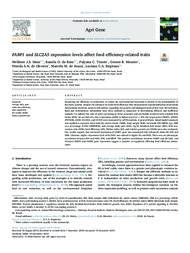FABP1 and SLC2A5 expression levels affect feed efficiency-related traits.
FABP1 and SLC2A5 expression levels affect feed efficiency-related traits.
Author(s): DINIZ, W. J. S.; ROSA, K. O. da; TIZIOTO, P. C.; MOURÃO, G. B.; OLIVEIRA, P. S. N. de; SOUZA, M. M. de; REGITANO, L. C. de A.
Summary: Improving the efficiency of production to reduce the environmental footprints is pivotal to the sustainability of livestock systems. Despite the advances in cattle feed efficiency (FE) measurement and identification of potential mechanisms involved, much is still unclear regarding the genetic and biological basis of this trait. Nevertheless, lipid and carbohydrate metabolism have been outlined as important in determining efficient and inefficient animals. To address the role of genes partaking in these processes and previously involved with residual feed intake (RFI), we carried out a liver expression profile in Nelore steers (n = 83). Six target genes (FABP1, FADS2, PPP1R26, RGS2, SLC2A5, and UCP2) were measured by qPCR analysis. A general linear mixed model approach was applied to associate them with dry matter intake (DMI), body weight (BW), metabolic BW (MBW, kg), DMI as a percentage of BW (DMI%BW), and average daily gain (ADG, kg/d). Residual feed intake (RFI), feed conversion ratio (FCR), feed efficiency (FE), Kleiber index (KI), and relative growth rate (RGR) were also evaluated. Our results support that increased expression of FABP1 gene was associated with enhanced values for RFI and DMI. Likewise, higher expression level of SLC2A5 was related to higher KI and RGR. There was no phenotypic correlation between RFI and ADG, BW, and MBW. The positive correlations between FABP1 and SLC2A5, and between FABP1 and FADS2 gene expression suggest a putative co-regulation affecting feed efficiency phenotypes.
Publication year: 2020
Types of publication: Journal article
Observation
Some of Embrapa's publications are published as ePub files. To read them, use or download one of the following free software options to your computer or mobile device. Android: Google Play Books; IOS: iBooks; Windows and Linux: Calibre.
Access other publications
Access the Agricultural Research Database (BDPA) to consult Embrapa's full library collection and records.
Visit Embrapa Bookstore to purchase books and other publications sold by Embrapa.

